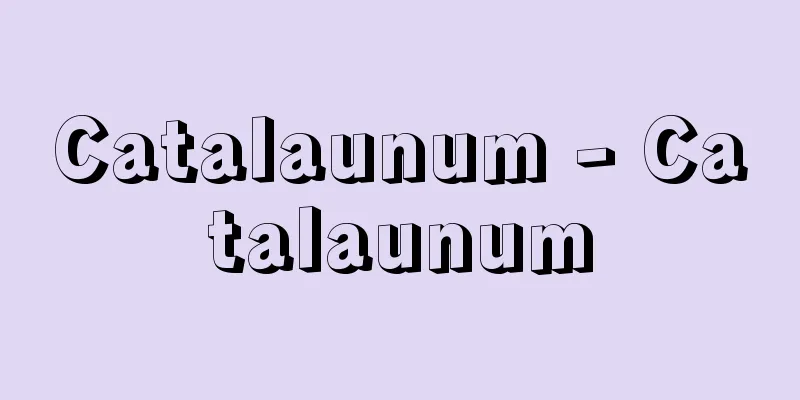Prose poem

|
This refers to poetry that is written using the form of prose, without relying on traditional meter. It is different from so-called poetic prose or beautiful prose. Since ancient times, poetry has always been written using alliteration and rhyme, and has been treated as a synonym for verse, but in the 19th century in France, Baudelaire rebelled against the traditional classical meter and set a new direction with his Petits Poèmes en Prose (1869, later called Parisian Melancholy). Since then, many Symbolist poets such as Mallarmé and Rimbaud have followed this path, and in the 20th century, many surrealists such as Apollinaire and Breton also wrote prose poems. In English, which has a clearer rhythm than French, there is a strong tendency to lean towards either poetry or prose. However, Poe defined poetry as "the metrical creation of beauty" in "Principles of Poesy" (1848-49) and regarded it strictly as verse, but on the other hand he pioneered a kind of prose poetry such as "The Fall of the House of Usher" (1839). In the 20th century, prose poetry was written in America as well, although the number is small, such as by W. C. Williams, Shapiro, and Ashbery. In Japan, influenced by Baudelaire, Hagiwara Sakutaro and Miyoshi Tatsuji attempted prose poetry, and in the early Showa era, a prose poetry movement led by Kitagawa Fuyuhiko, Anzai Fuyue and others became popular, centered around the magazine Poetry and Poetics. After World War II, many writers such as Tamura Ryuichi, Yoshimoto Takaaki, Irisawa Yasuo, Tsuburai Tetsuzo, and Hasegawa Ryusei appeared, and prose poetry seems to have become established. [Shunichi Niikura] "The Magnetic Field of Nonsense" by Shunichi Niikura (1980, Renga Shobo Shinsha) " "The Principles of Poetry" (included in the Complete Works of Sakutaro Hagiwara, Volume 6, 1975, Chikuma Shobo) " "A Study of Poetry" by Yukio Haruyama (1936, Daiichi Shobo) Source: Shogakukan Encyclopedia Nipponica About Encyclopedia Nipponica Information | Legend |
|
伝統的な韻律によらずに、散文の形式を借りて表現された詩をいう。いわゆる詩的散文、あるいは美文とは異なる。詩は古くからかならず頭韻や脚韻を用いて書かれ、韻文と同義語に扱われてきたが、19世紀になってフランスで、従来の古典主義の韻律に反発して、ボードレールが『小散文詩』Petits Poèmes en Prose(1869。のちに『パリの憂鬱(ゆううつ)』とよばれた)を出して新しい方向づけをした。それ以来、マラルメやランボーなど多くの象徴派詩人たちがこれを踏襲し、20世紀ではアポリネールやブルトンらの超現実主義者たちも多く散文詩を書いている。フランス語に比べてリズムの抑揚がはっきりしている英語では、詩か散文かどちらかに偏する傾向が強い。しかしポーは『詩の原理』(1848~49)のなかで詩を「美の韻律的創造」と定義して、厳密に韻文としてとらえたが、他方では『アッシャー家の崩壊』(1839)のような一種の散文詩の領域を開拓した。20世紀ではW・C・ウィリアムズ、シャピロ、アシュベリなど数は少ないが、アメリカにおいても散文詩は書かれている。 日本ではボードレールの影響を受けて萩原朔太郎(はぎわらさくたろう)や三好達治(みよしたつじ)が散文詩を試み、昭和初年代には雑誌『詩と詩論』を中心に北川冬彦、安西冬衛(あんざいふゆえ)らの散文詩運動が盛んになり、第二次世界大戦後は田村隆一、吉本隆明(よしもとたかあき)、入沢康夫(いりさわやすお)、粒来(つぶらい)哲蔵、長谷川龍生(はせがわりゅうせい)など多くの書き手が現れて、散文詩は定着したと思われる。 [新倉俊一] 『新倉俊一著『ノンセンスの磁場』(1980・れんが書房新社)』▽『「詩の原理」(『萩原朔太郎全集 第6巻』所収・1975・筑摩書房)』▽『春山行夫著『詩の研究』(1936・第一書房)』 出典 小学館 日本大百科全書(ニッポニカ)日本大百科全書(ニッポニカ)について 情報 | 凡例 |
<<: Three-quarter profit and loss - sanbunsoneki
>>: Prose - sanbun (English spelling) prose English
Recommend
redtop
...The Japanese name means "bran ear" a...
The Lady Who Became a Fox - The Lady Who Became a Fox
…He was born into a literary family with his gran...
Zhukov, EM (English spelling) ZhukovEM
...One of these was the application of the Marxis...
Pepper - Pepper (English spelling) Piper nigrum; pepper
An evergreen perennial vine of the Piperaceae fami...
Frog-like folktale - Frog-like folktale
...A general term for a group of folk tales belon...
Hyperlipidemia - Hyperlipidemia
A condition in which one or more lipid fractions, ...
Khotanese Saka - Khotanese Saka (English spelling)
Among the Central Asian Saka languages related t...
One drum - Ichinotsudumi
...A string is attached to the drum body and worn...
Acta Senatus - Acta Senatus
…The name was often given to messengers who sent ...
Christian Democracy - Christian Democracy
The ideology and philosophy of a political party b...
detective novel
…So, let us begin by examining the definition of ...
Acanthus montanus (English spelling) Acanthusmontanus
…[Hiroshi Aramata]. … *Some of the terminology th...
Kotoshironushi no Kami
A god who appears in the Kojiki and Nihon Shoki. A...
Olistostrome - Olistostrome (English spelling)
Large-scale submarine landslide deposits containi...
Divan
…In the 18th century, during the reign of Louis X...









